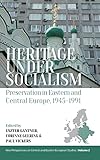Heritage under Socialism : Preservation in Eastern and Central Europe, 1945–1991 / ed. by Corinne Geering, Eszter Gantner, Paul Vickers.
Material type: TextSeries: New Perspectives on Central and Eastern European Studies ; 2Publisher: New York ; Oxford : Berghahn Books, [2021]Copyright date: ©2021Description: 1 online resource (254 p.)Content type:
TextSeries: New Perspectives on Central and Eastern European Studies ; 2Publisher: New York ; Oxford : Berghahn Books, [2021]Copyright date: ©2021Description: 1 online resource (254 p.)Content type: - 9781800732278
- 9781800732285
- Communism and culture -- Europe, Central -- Case studies
- Communism and culture -- Europe, Eastern -- Case studies
- Cultural property -- Protection -- Political aspects -- Europe, Central -- Case studies
- Cultural property -- Protection -- Political aspects -- Europe, Eastern -- Case studies
- Socialism and culture -- Europe, Central -- Case studies
- Socialism and culture -- Europe, Eastern -- Case studies
- HISTORY / Europe / Eastern
- History: 20th Century to Present, Heritage Studies, Memory Studies
- 363.69094 23
- DJK50 .H475 2022
- online - DeGruyter
| Item type | Current library | Call number | URL | Status | Notes | Barcode | |
|---|---|---|---|---|---|---|---|
 eBook
eBook
|
Biblioteca "Angelicum" Pont. Univ. S.Tommaso d'Aquino Nuvola online | online - DeGruyter (Browse shelf(Opens below)) | Online access | Not for loan (Accesso limitato) | Accesso per gli utenti autorizzati / Access for authorized users | (dgr)9781800732285 |
Frontmatter -- Contents -- Illustrations -- Acknowledgments -- INTRODUCTION Heritage under Socialism: Trajectories of Preserving the Tangible Past in Postwar Eastern and Central Europe -- PART I Transfers and Exchanges in Heritage Policies and Practices -- CHAPTER 1 The Past Belongs to the Future: Heritage in Soviet Policymaking on Cultural Development -- CHAPTER 2 International Experts— National Martyrdom— Socialist Heritage: The Contribution of the Polish People’s Republic to the Early UNESCO World Heritage Program -- CHAPTER 3 International Tourism and the Making of the National Heritage Canon in Late Soviet Ukraine, 1964–1991 -- CHAPTER 4 International Contacts and Cooperation in Heritage Preservation in Soviet Estonia, 1960–1990 -- PART II Canonizing and Contesting the Past: Heritage, Place, and Belonging under Socialism -- CHAPTER 5 Socialist Royalty? The Ambiguities of the Reconstruction of the Royal Residence in Budapest in the 1950s -- CHAPTER 6 Justifying Demolition, Questioning Value: Urban Typologies and the Concept of the “Historic Town” in 1960s Romania -- CHAPTER 7 Making Sense of Socialism through Heritage Preservation: Stories from Northwest Bohemia -- CHAPTER 8 Socialism and the Rise of Industrial Heritage: The Preservation of Industrial Monuments in the German Democratic Republic -- CONCLUSION Transnational Heritage Networks in Socialist Eastern and Central Europe -- Index
restricted access online access with authorization star
http://purl.org/coar/access_right/c_16ec
How was heritage understood and implemented in European socialist states after World War II? By exploring national and regional specificities within the broader context of internationalization, this volume enriches the conceptual, methodological and empirical scope of heritage studies through a series of fascinating case studies. Its transnational approach highlights the socialist world’s diverse interpretations of heritage and the ways in which they have shaped the trajectories of present-day preservation practices.
Mode of access: Internet via World Wide Web.
In English.
Description based on online resource; title from PDF title page (publisher's Web site, viewed 25. Jun 2024)


